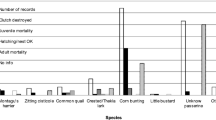Summary
In response to natural mortality in a local population of wintering black-capped chickadees, Parus atricapillus, high-ranked flock regulars are usually replaced rapidly by flock switchers, while low-ranked regulars are not replaced. A series of removal experiments was done to examine the replacement process. A large outdoor aviary was used to house the removed birds, all of which were returned to their flocks no more than 4 days after removal. Of 10 birds taken, all 6 of the high-ranked ones (3 males, 3 females) were replaced by flock switchers. All inserting switchers made sudden jumps in rank; each was seen to supplant regulars of its sex the day after removal. All 10 removed birds, including the 6 that had been replaced by switchers, regained their former status immediately upon release. The 6 switchers that had inserted into the artificial openings were all driven away, and stayed away from the flock for an average of 15 days. Four removed birds were not replaced. All were males from the bottom-ranked pair in their flock. This is consistent with field observations: of 58 low-ranked regulars disappearing naturally over 7 winters, none was replaced by a switcher, although to do so would be an apparent jump in rank for any switcher.
Similar content being viewed by others
References
Barash DP (1974) An advantage of winter flocking in the black-capped chickadee, Parus atricapillus. Ecology 55:674–676
Beletsky LD, Orians GH (1987) Territoriality among male red-winged blackbirds. Behav Ecol Sociobiol 20:21–34
Colquhoun MK (1942) Notes on the social behaviour of Blue Tits. Br Birds 35:234–240
Drent PJ (1983) The functional ethology of territoriality in the great tit (Parus major L.) Ph D thesis, University of Groningen
Ekman J (1979) Non-territorial willow tits Parus montanus de Selys-Longchamp in late summer and early autumn. Ornis Scand 10:262–267
Ekman J, Cederholm G, Askenmo C (1981) Spacing and survival in winter groups of willow tit Parus montanus and crested tit P. cristatus — a removal study. J Anim Ecol 50:1–9
Glase JC (1973) Ecology of social organization in the black-capped chickadee. Living Bird 12:235–267
Gullion GW (1981) Non-drumming males in a Ruffed Grouse population. Wilson Bull 93:372–382
Hannon SJ (1983) Spacing and breeding density of willow ptarmigan in response to an experimental alteration of sex ratio. J Anim Ecol 52:807–820
Hansen AJ, Rohwer S (1986) Coverable badges and resource defence in birds. Anim Behav 34:69–76
Hartzler JE (1970) Winter dominance relationship in black-capped chickadees. Wilson Bull 82:427–434
Hinde RA (1952) The behaviour of the great tit (Parus major) and some other related species. Behaviour (Suppl) 2:1–201
Loery G, Nichols JD (1985) Dynamics of a black-capped chickadee population, 1958–1983. Ecology 66:1195–1203
Morley A (1950) The formation and persistence of pairs in the Marsh Tit. Br Birds 43:387–393
Odum EP (1942) Annual cycle of the Black-capped Chickadee-3. Auk 59:499–531
Petrinovich L, Patterson TL (1982) The White-crowned Sparrow: stability, recruitment, and population structure in the Nuttal subspecies (1975–1980). Auk 99:1–14
Power HW (1975) Mountain bluebirds: experimental evidence against altruism. Science 189:142–143
Saether B-E, Fonstad T (1981) A removal experiment showing unmated females in a population of chaffinches. Anim Behav 29:637–639
Smith SM (1967) Seasonal changes in the survival of the Black-capped Chickadee. Condor 69:344–359
Smith SM (1976) Ecological aspects of dominance hierarchies in Black-capped Chickadees. Auk 93:95–107
Smith SM (1978) The “underworld” in a territorial sparrow: adaptive strategy for floaters. Am Nat 112:571–582
Smith SM (1984) Flock switching in chickadees: why be a winter floater? Am Nat 123:81–98
Smith SM (1987) Social dynamics in wintering black-capped chickadees. Proc. 19th Int Ornith Congr (in press)
Thompson CF (1977) Experimental removal and replacement of territorial male yellow-breasted chats. Auk 94:107–113
Author information
Authors and Affiliations
Rights and permissions
About this article
Cite this article
Smith, S.M. Responses of floaters to removal experiments on wintering chickadees. Behav Ecol Sociobiol 20, 363–367 (1987). https://doi.org/10.1007/BF00300682
Received:
Accepted:
Issue Date:
DOI: https://doi.org/10.1007/BF00300682




